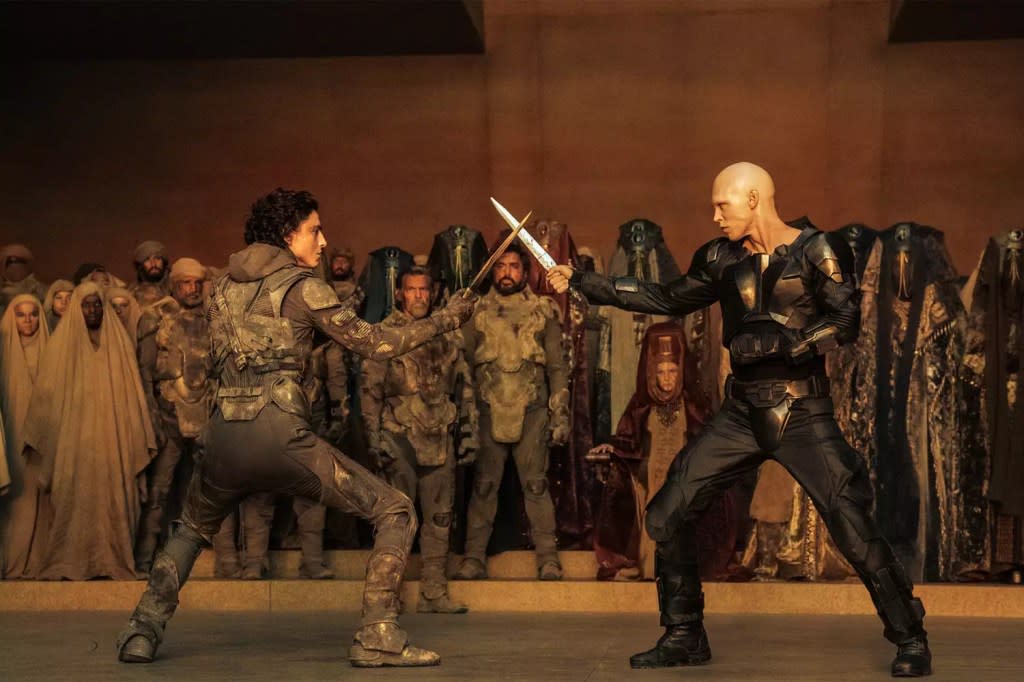How Dune: Part Two’s Final Fight Scene Came Together

- Oops!Something went wrong.Please try again later.
ComingSoon Editor-in-Chief spoke to Dune: Part Two editor Joe Walker about the film’s incredible final fight scene between Paul Atreides and Feyd-Rautha. Walker discussed how the scene came together while paying homage to earlier scenes and using reaction shots to bolster the experience. Dune: Part Two is out now on digital and comes out May 14 on 4K, Blu-ray, and DVD.
Tyler Treese: I wanted to ask you about your approach to editing the final fight scene in Dune: Part Two between Timothée Chalamet and Austin Butler because there’s a very realistic quality to it. It’s not this super prolonged battle that I could see a lot of people wanting. It’s very realistic and it ends suddenly, and that’s how real fights are. Can you speak to your approach to that?
Joe Walker: Thanks for pointing to that scene. It’s one of my favorite scenes and it was enormous fun to cut that. Really fun, like a kind of severe ballet, isn’t it? I think always the secret with those fights and what Denis is so brilliant at doing and with the help of his, you know, actors and his stunt coordinator, Roger [Yuan], is building character into it. So there’s an opposition of styles, and it reflects the savagery of the Harkonnen. You’ve seen Feyd fight, but not like that. This is all out. Paul’s brilliance is at adapting, which is really part of his survival as a young man thrown into the most hostile imaginable universe.
It’s terrific, but it also pays some homage to earlier scenes. I always thought, I don’t know if it was the intention, but I always felt that looking down and seeing the knife in the guts was a reference to the end of the Paul/Gurney training fight at the beginning of Part One. That’s, of course, always a bit of a lovely thing for an editor to see is you measure the journey of a character through little milestones by the side of the road, whether it’s a hand in water or whether it’s the turn of a fight and the fact that they’ll both go down. The idea that you would’ve joined me in death that, that Gurney line. There’s a lot.
Of course, as a scene, it was very complicated to cut because, you have a visceral fight that the actors really threw themselves at beyond, beyond, beyond. But also, you have almost the entire cast sitting around, and they could amplify every little moment. There’s some brilliant cutaways. He didn’t need very much to get the strong flavor. You know, I particularly love Javier Bardem/Stilgar’s look as he thinks Paul is dead or gonna be dead, and the whole of his world collapses, and it’s in just one small shot. The mother, Jessica, stands upright and her eyes are wild, and [Josh Brolin’s] Gurney is gritting his teeth. There’s these magical [moments with] Florence and all of that in Chani, par excellence. That kind of strong axis of Paul and Chani in that scene, and the way that Feyd tramples upon that line in a way. It’s all character-driven stuff, which I really love. It means that the audience’s attention is… You’ve got a dazzling fight, but there’s always the kind of tectonic plates moving underneath it of characters in confluence and in conflict.
Was there any one particular scene that was hard to get right with what you were trying to do this time around in Dune: Part Two?
I think actually sort of one of the biggest challenges was in the middle of the film, and it was more sort of carving out… You cut something, and you look repeatedly. We cut in this room. Denis will sit there. We have a tiny monitor actually, and just stereo sound. It’s quite just about getting the story right and giving it the best kind of workout that you can give it. Then we’ll go and screen it sort of pretty much weekly, maybe on a Monday morning at nine, good strong coffee, and off we go. We see where it is to measure it. I think you sort of get to feel what it’s like to be an audience member really. You are as fresh as you can be on a Monday morning. It’s always good to have had a day off beforehand, a good night’s sleep, and then you see it as an audience does.
Then there’s some moment where, with a world as complicated as Dune and the factions and the politics and the kind of mechanics of the world, there is so deep, so rich [lore in] this world. This starts in the book and it’s really brought out by Denis and his creative team to kind of investigate. Sometimes, it’s like you are constructing a very delicate sculpture where if you make too many things too much the same size, then it works, but it’s boring, or it’s just neutral. It’s losing its character, its flavor. In this one, it was much, much more trying to build big peaks and engender sort of very emotional response.
The post How Dune: Part Two’s Final Fight Scene Came Together appeared first on ComingSoon.net - Movie Trailers, TV & Streaming News, and More.

